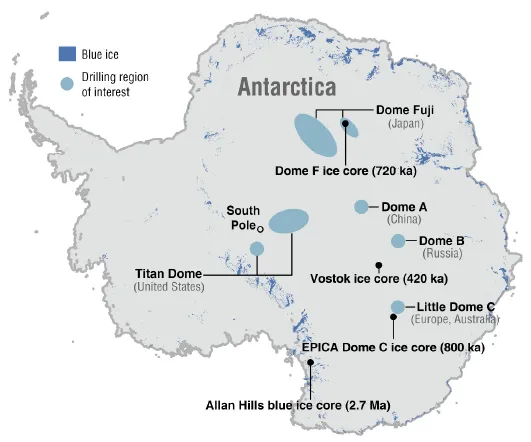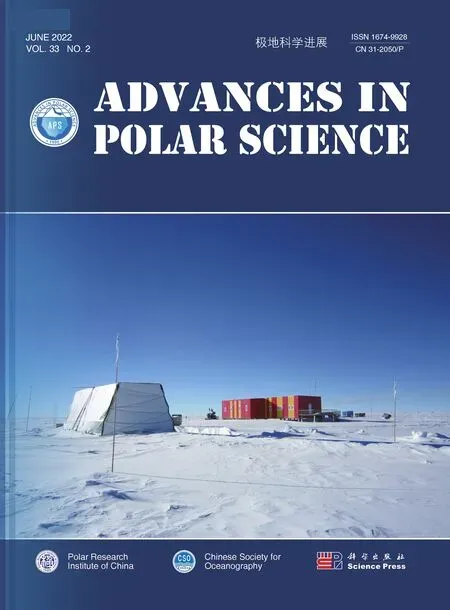The older ice, the better science
2021-08-18HOUShugui
HOU Shugui
The older ice, the better science
HOU Shugui*
School of Oceanography, Shanghai Jiao Tong University, Shanghai 200240, China
Antarctica, ice cores,blue ice, Mid-Pleistocene Transition (MPT)
Ice cores have revolutionized our views of the Earth system. They record past climatic and environmental parameters that range on time scales from synoptic events to hundreds of thousands of years. For instance, the Vostok ice core reached an age of 420 ka (thousand years) (Figure 1), revealing a close linkage between climate and greenhouse gas concentrations over the last four glacial-interglacial cycles (Petit et al., 1999). Up to now, the longest ice core record is dated back to 800 ka from the Antarctic EPICA Dome C ice core (Jouzel et al., 2007). One of the most important findings from this record is that the present concentrations of primary greenhouse gases (i.e., CO2, CH4and N2O) are at higher levels than any time during the past 800 ka, leading to a wide concern about greenhouse gas emissions from human activities and their roles in recent global warming.
Marine core isotopic data revealed a significant shift at about 1 Ma (million years) in the dominant cycles of climate variability from 41 ka to 100 ka (Lisiecki and Raymo, 2005), a phenomenon hence termed the Mid-Pleistocene Transition (MPT). Before the MPT, global climate had a dominant cyclicity of 41 ka, a period associated with the variations in Earth’s axial tilt. After MPT, the climate system developed a quasi-cyclicity of 100 ka associated with variations in the eccentricity of Earth’s orbit. Although several hypotheses have been developed to explain MPT in relation to greenhouse effect, the exact mechanism remains unclear. Ice cores are a unique climate and environmental archive, because they contain direct samples of ancient atmosphere, and have the advantage of precise dating, high temporal resolution and good continuity. Therefore, ice core records extending beyond one million years are extremely valuable for verifying MPT, and identifying its causes. They will further deepen our understanding of the relationship between greenhouse gases and climate. Therefore, looking for ice older than 800 ka, hopefully reaching 1.5 Ma, is the most urgent challenge and one of the priorities recommended by International Partnerships in Ice Core Sciences (IPICS).

Figure 1 A map of Antarctica, showing the blue ice areas and the potential drilling regions for the oldest ice. Data of blue ice and drilling region of interest are from Feng et al. (2016) and Voosen (2021), respectively.
In practice, any potential sites for retrieving such old ice should have considerable ice thickness, low accumulation rate, low ice velocity and no basal melting. These conditions narrow the search down to central East Antarctica (Figure 1). The oldest ice will inevitably be very close to the bed of the ice sheet, where it is likely to be disturbed by ice flow. Before any ice core drilling, it is essential to establish a reliable local depth-age relationship through extensive ice sheet modeling with inputs from remote sensing data, information on critical features of bedrock topography, ice thickness, and ice sheet internal layers, together with limited ground traverses andobservations. If possible, multiple ice cores should be obtained for more reliable records.
Dome A, the highest point on the Antarctic Ice Sheet, is a good example for such a site that potentially meets all these requirements (Zhao et al., 2018). Although ice core drilling began at the Chinese Kunlun Station near Dome A in 2012, its progress has been hindered by logistic difficulties due to the remoteness of the site. The Dome F ice core reaches an age of 720 ka, and recent studies indicate that the region immediately south of the Dome F drilling site continues to be a good candidate for obtaining even older ice cores (Karlsson et al., 2018).
Recent remote sensing and ice sheet modeling studies identified two candidate sites at Little Dome C, an area ~35 km southeast of the EPICA Dome C ice core drilling site (Figure 1) (Lilien et al., 2021). The European Beyond EPICA consortium established a drill camp in 2019 at Little Dome C. An ice-flow model tuned to the isochrones suggests an ice age likely reaching 1.5 Ma at ~2500 m in depth, i.e., ~65 m above the basal unit and ~265 m above the bedrock at Little Dome C (Lilien et al., 2021). A separate Australian team, traversing to the site from the Casey Station, have commenced a program to obtain a second Little Dome C ice core. The projects are independent but have a letter of agreement which undertakes to assist each other as capability allows and to collaborate on key publications. Together, they are working towards the objective of replicate MPT ice cores.
A US-led team explored two other possible areas for ice core drilling near the South Pole in 2016 and 2017 (Figure 1). However, new data from radar and laser altimetry suggest that Titan Dome is unlikely to contain ice old enough to capture MPT (Beem et al., 2021). In addition, Russian scientists have attempted to drill for old ice at Dome B, about 300 km away from their historic Vostok Station (Figure 1).
Recently, discontinuous old ice has also been discovered in blue ice areas around the margin of the ice sheet. The pioneer work from the Allan Hills Blue Ice Area (Figure 1) provides snapshots of past climate and atmospheric composition as far back as 2.7 Ma (Yan et al., 2019). Although these snapshots provide an incomplete picture of the Quaternary climate, the oldest ice is most likely found in the discontinuous sections of the blue ice areas. Much of this potential archive remains to be explored.
Finally, it’s worth pointing out that modern dating techniques, especially radiometric dating methods with a time scale up to million years (e.g.,36Cl,40Ar and81Kr), allow us to correlate both continuous and discontinuous ice core records to other climate records and external forcings. For instance,81Kr is a cosmogenic radionuclide with a half-life of 229±11 ka, hence a suitable element to date samples over the age range of 40 ka to 1.3 Ma. In recent years, the sample size needed for81Kr dating has been drastically reduced by the emerging analytical method of Atom Trap Trace Analysis (ATTA) (Lu et al., 2014), which enables its application for old ice core dating.
Acknowledgments Thanks to Dr. Ian Allison for thoughtful comments, to Dr. Wangbin Zhang for drawing Figure 1. This work was supported by the Natural Science Foundation of China (Grant nos. 41830644, 42021001).
Beem L H, Young D A, Greenbaum J S, et al. 2021. Aerogeophysical characterization of Titan Dome, East Antarctica, and potential as an ice core target. Cryosphere, 15(4): 1719-1730, doi:10.5194/tc-15-1719-2021.
Feng M, Sexton J O, Channan S, et al. 2016. A global, high-resolution (30-m) inland water body dataset for 2000: First results of a topographic-spectral classification algorithm. Int J Digit Earth, 9(2): 113-133, doi:10.1080/17538947.2015.1026420.
Jouzel J, Masson-Delmotte V, Cattani O, et al. 2007. Orbital and millennial Antarctic climate variability over the past 800,000 years. Science, 317(5839): 793-796, doi:10.1126/science.1141038.
Karlsson N B, Binder T, Eagles G, et al. 2018. Glaciological characteristics in the Dome Fuji region and new assessment for “Oldest Ice”. Cryosphere, 12(7): 2413-2424, doi:10.5194/tc-12-2413-2018.
Lilien D A, Steinhage D, Taylor D, et al. 2021. Brief communication: New radar constraints support presence of ice older than 1.5 Myr at Little Dome C. Cryosphere, 15(4): 1881-1888, doi:10.5194/tc-15-1881-2021.
Lisiecki L E, Raymo M E. 2005. A Pliocene-Pleistocene stack of 57 globally distributed benthic δ18O records. Paleoceanography, 20(1): PA1003, doi:10.1029/2004PA001071.
Lu Z T, Schlosser P, Smethie W M Jr, et al. 2014. Tracer applications of noble gas radionuclides in the geosciences. Earth Sci Rev, 138: 196-214, doi:10.1016/j.earscirev.2013.09.002.
Petit J R, Jouzel J, Raynaud D, et al. 1999. Climate and atmospheric history of the past 420,000 years from the Vostok ice core, Antarctica. Nature, 399: 429-436, doi:10.1038/20859.
Voosen P. 2021. Hunt begins for ancient Antarctic ice. Science, 374(6566): 388-389, doi:10.1126/science.acx9394.
Yan Y, Bender M L, Brook E J, et al. 2019. Two-million-year-old snapshots of atmospheric gases from Antarctic ice. Nature, 574(7780): 663-666, doi:10.1038/s41586-019-1692-3.
Zhao L, Moore J C, Sun B, et al. 2018. Where is the 1-million-year-old ice at Dome A? Cryosphere, 12(5): 1651-1663, doi:10.5194/tc-12-1651-2018.
Queries and discussions on this article should be made by E-mail directly with the corresponding author.
12 February 2022;
24 February 2022;
20 April 2022
: Hou S G. The older ice, the better science. Adv Polar Sci, 33(2): 121-122,doi:10.13679/j.advps.2022.0004
, ORCID: 0000-0002-0905-3542, E-mail: shuguihou@sjtu.edu.cn
10.13679/j.advps.2022.0004
杂志排行
Advances in Polar Science的其它文章
- “Opinion Editorial” category attracts more attention
- One special issue will be published in September 2023
- The evaluation of biological productivity by triple isotope composition of oxygen trapped in ice-core bubbles and dissolved in ocean:a review
- Development of the International Polar Years and their benefits for China
- Inventory of unintentional POPs emission from anthropogenic sources in Antarctica
- Community structure of mesopelagic fauna and the length-weight relationships of three common fishes in the Cosmonaut Sea, Southern Ocean
